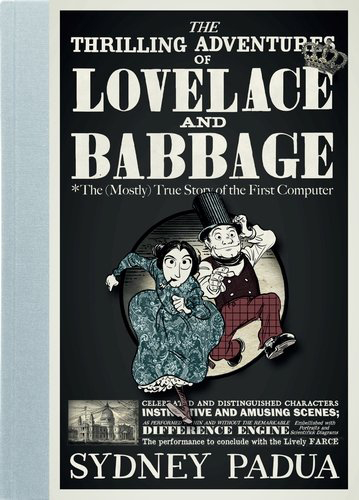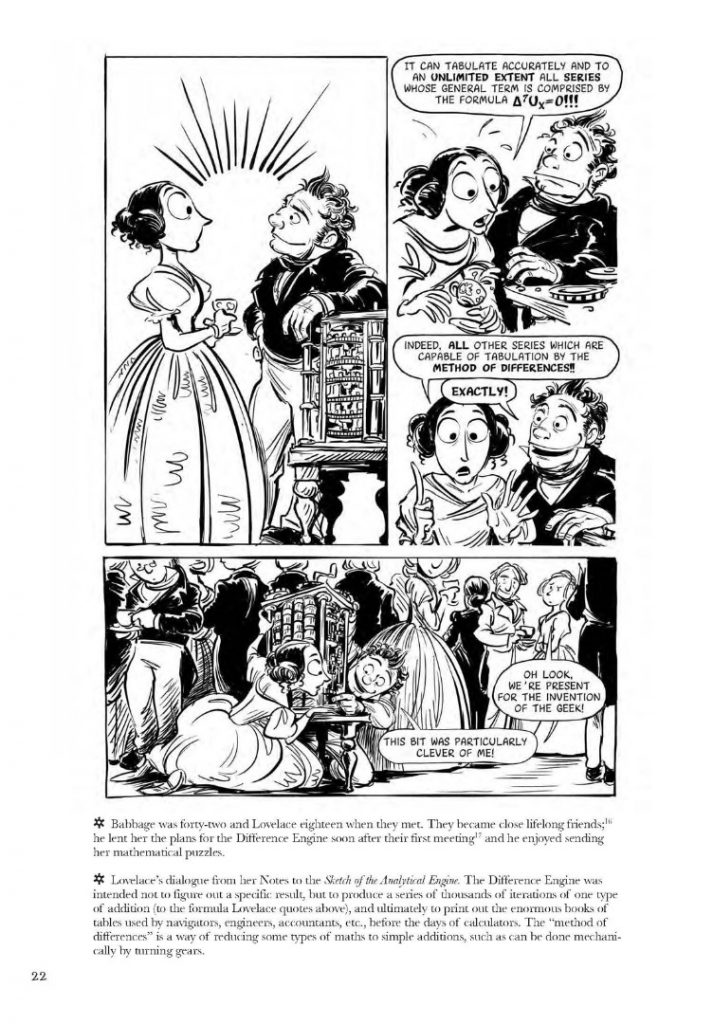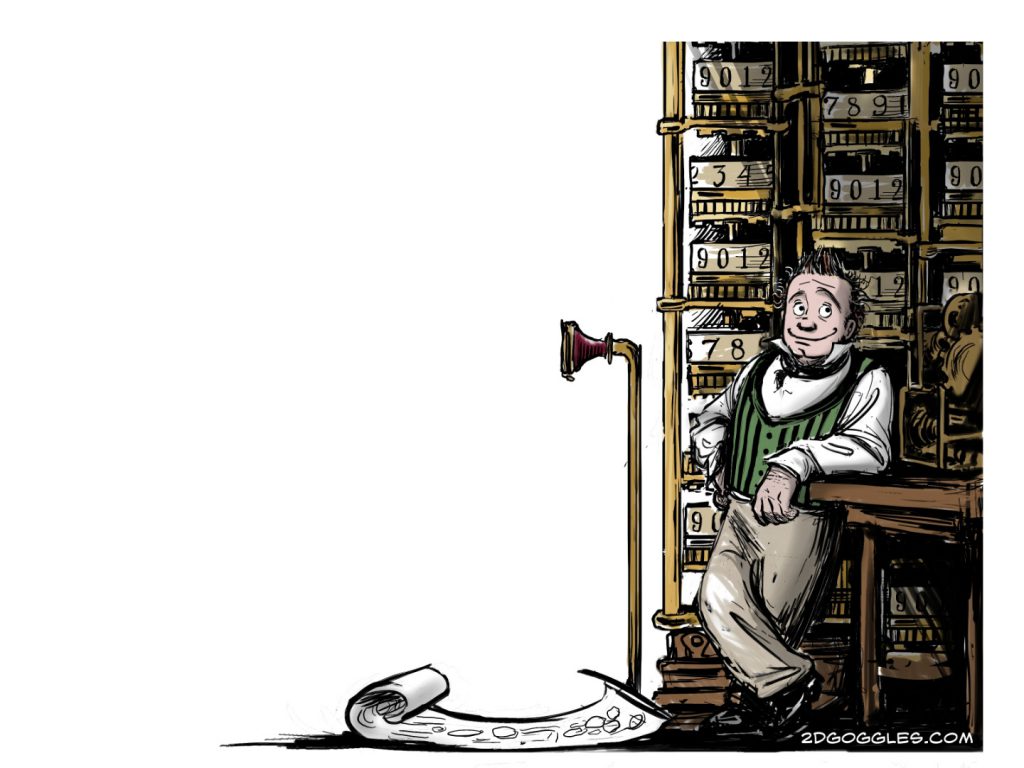Review: The thrilling adventures of Lovelace and Babbage: the (mostly) true story of the first computer, by Sydney Padua
Article DOI: https://dx.doi.org/10.15180/150408
Keywords
Babbage, Comic, Computer, Lovelace, review, Sydney Padua
The Thrilling Adventures of Lovelace and Babbage
https://dx.doi.org/10.15180/150408/001What we have here is a very unusual study of two familiar but fascinating Victorians: Ada, Countess of Lovelace, famous in her lifetime as Lord Byron’s daughter, but also a second-generation mathematical enthusiast on her mother’s side; and Charles Babbage, economist, engineer, and zealous scientific reformer. One of Babbage’s passions was designing huge cogwheel-driven machines to process numbers by steam power: his Analytical Engine, had it been built, would have had most of the features of a multi-purpose programmable computer. Lovelace, his friend and collaborator, translated a French-language description of the planned Engine and published it in 1842 with a contribution of her own: officially just a set of ‘Notes’ to the translation, Lovelace’s piece added far more detail, giving the reading public a clear description of what we would now call programming, and an elegant account of the new fields of enquiry which the machine might open up. Yet the project, though never entirely forgotten, had little or no influence on the computers which achieved the same goals using high-speed electronics in the 1940s. Nonetheless, as smaller, faster and cheaper machines reached into every area of twentieth-century life, first Babbage and then Lovelace gained a new prominence as early visionaries of the computer revolution.
And then people started to write jokes about them.

The Thrilling Adventures of Lovelace and Babbage arose almost entirely by accident. In 2009, Sydney Padua, an animator and occasional cartoonist, was asked to help out with material for Ada Lovelace Day, the annual celebration of women in technology. Padua put together a short graphical retelling of the standard Lovelace/Babbage story, lightened by breezy anachronisms and a throwaway comic-book ending. In the real world, Lovelace died of uterine cancer at 36, having published little beyond the 1842 article; Babbage lost the confidence of his financial backers and died embittered and unfulfilled, his elaborate engines still on the drawing board. In the cartoon, the duo ‘lived on and built a giant calculating engine and used it to fight crime and have adventures’ attired in superhero garb. There it would have ended – except that most readers took this as a curtain-raiser to a regular series. Their expectation was gradually fulfilled as Padua warmed to her subject, the flexibility of the web comic format allowing her to build increasingly ambitious stories in odd moments snatched from work commitments.
The idea of Babbage triumphant in a steam-driven information society recalls William Gibson and Bruce Sterling’s 1990 novel The Difference Engine, a key source for steampunk culture, but Padua did not encounter this alternative history until her own was well developed (Padua, 2009). Her treatment is much looser, and unapologetically silly (headline in newspaper account of the 1837 financial crash: ‘Wall Street Trader Leaps From Top Floor, Breaks Ankle’). Lovelace and Babbage is not a graphic novel but a scattershot compendium of episodes, mostly redrawn and tidied up from the frantically improvised web originals. ‘The Client’, featuring Queen Victoria, broadly continues the prologue’s off-kilter biography with ever-growing artistic licence; ‘The Economic Model’ is more obviously satirical, putting a steampunk veneer on a tale of banking woes drawn firmly from the present day (or perhaps not: the gags highlight the perennial short-sightedness of mathematical predictions, and the recirculation of crash and bailout across the decades). ‘Mr Boole Comes to Tea’ and ‘Person from Porlock’ are single-joke squibs based on, respectively, computational logic and the dream-composition of Coleridge’s Kubla Khan. The longest piece, ‘User Experience’, centres on Mary Ann Evans, better known as the novelist George Eliot, who is unwillingly recruited to a steampunk text-mining venture: the book’s one unambiguous pass of the Bechdel-Wallace test occurs as Evans and Lovelace meet in the bowels of the Engine to discuss cloud storage and cats.
The artwork complements the absurd concepts beautifully. Facial expression is Padua’s particular strong suit: her characters spend most of their time registering bewilderment or exasperation in a thousand subtly different ways, as well they might. Isambard Kingdom Brunel (who collaborated with Babbage on railway projects in reality) is rather conventionally portrayed as a burly, cigar-chomping shortarse in a giant stovepipe hat, but there is something irresistibly funny about his habit of leaning back and shooting the breeze as the results of his reckless engineering take hold. The largely superfluous central gimmick of having the action take place in an ‘anti-informative Pocket Universe’, sealed off from our own timestream and operating to its own logic, here permits the book’s best insider joke (p 204): where the IT industry of our world follows Moore’s Law of progressive miniaturisation, Pocket Universe computers are subject to Brunel’s Law, becoming ever more unnecessarily gigantic until they blot out the sky.
Academic reviewers addressing historical fiction often take it as their sacred responsibility to complain about the inaccuracies, preferably in almost unintelligible detail, in order that other critics can in turn moan about academics as petty obsessives. It’s a disheartening task, and mercifully pointless here: Padua is well aware of her sins against history and chronicles them remorselessly in the text. Victoria is Queen around 1830, and the Duke of Wellington Prime Minister in 1837, simply because they’re more fun as cartoons than their real-world-timeline equivalents. Elsewhere, the storyline not only drags in any and every nineteenth-century celebrity of significant public eminence or outstanding facial hair, but cheerfully raids the greatest hits of twentieth- and twenty-first century computing, with concepts from John Searle’s Chinese Room argument in artificial intelligence theory to the extraordinary Newlyn-Phillips hydraulic computer popping up in ingenious period dress.
Padua’s work is, in fact, rather better researched than certain more solemn texts on Lovelace and Babbage. (This is not so surprising, as the best knockabout comedy is often underpinned by attention to serious detail: consider Les Dawson’s genuine talent as a pianist, or the thoroughly plausible attack plan in Dr Strangelove.) With no formal historical training, Padua has gone rather deeply into the primary source base, aided by repositories such as Google Books and the novel possibilities of digital full-text searching (which also finds its steam-age equivalent in the narrative). Readers who know the literature will have an advantage in places, as when the two principals end up fighting for the Queen’s attention, with all the dialogue drawn from their published work – Lovelace desperate to make a convincing case for funding the engine project, Babbage self-centred, tactless and self-defeating. It would be hard to improve on Padua’s characterisation of Babbage as a ‘blend of Mr Pickwick, Mr Toad, Don Quixote and Leonardo da Vinci’, and only the most scrupulous and least jaded of historians would query her observation that his 1830 pamphlet Reflections on the Decline of Science in England might as well have been titled Dear Royal Society of Really Important People: You Are All Corrupt Idiots.
Then there are the notes. Alan Moore and Eddie Campbell’s From Hell (1999) started a trend for source documentation in graphic novels, with endnote sections outlining historical research and even challenging the main narrative. Padua goes further, littering the story pages themselves with footnotes. This is a bold decision: even at the sober end of the popular non-fiction market, many editors rank footnotes almost with mathematical equations in their power to scare off the casual bookstore browser.[1] As demonstrated by writers from Flann O’Brien to Jasper Fforde, however, annotation can also be subverted for comic effect.[2] Padua’s angle is to expand the notes to Brunellian extremes. Most pages carry one or more shortish notes from the perspective of our world, often citing sources for stranger-than-fiction quoted material. Some footnotes themselves have endnotes, much longer sections of (mostly) plain text which pop up between the graphic episodes, revealing something of Padua’s own research journey. A few of these endnotes, in turn, have their own footnotes. In short, Padua has her cake and eats it whilst flinging it all over the tearoom, using the joke of her documentation obsession to license an obviously sincere project to share her fascination with the stories behind the stories.

Eventually, the detail does start to pall (recalling in places one of the few eminently peculiar Victorians not mentioned here, Edwin Edward Foot, a particularly unpoetic poet celebrated for knocking down any rhetorical effect or ambiguity with tediously literal notes of clarification) (Pile, 1979). The author delegates her self-awareness on this point to her characters, as Queen Victoria cries ‘Enough!‘ and flings her sceptre into a particularly intricate exegesis of the abortive project to mould the Guelphic Order of Hanover into an honours system for the scientific elite. Tellingly, this text directed me to a useful recent article on the Guelphic honours which I hadn’t seen, in exactly the way that academic research notes should (Hanham & Hoskin, 2013).
The cleverest and most touching episode is the last, ‘Imaginary quantities’, in which Lovelace suffers an atavistic reversion to poetry and trips through her looking-glass. Yes, Lewis Carroll pastiche is well-trodden territory (particularly for lovers of recreational mathematics: there’s an acknowledged debt to Martin Gardner here), but the execution is pitch-perfect, particularly when Babbage charges in as the ageing, quixotic White Knight – an equation borrowed from Doris Langley Moore’s first full-length biography of Lovelace. This story interestingly deals with the historiography of Lovelace’s status and accomplishments. Popular narratives laud her as ‘the first programmer’ and, increasingly, as a crucial visionary (far more so than Babbage) of the computer’s potential; opposing accounts dismiss her as a rich dilettante who merely summarised Babbage’s efforts and could not even understand the established mathematics of her day. Padua has, of course, surveyed this debate, and despairs of it: an even more than usually nested irruption of footnotes charts impassioned researchers churning out monographs with titles like Ada Lovelace: A Fraud and a Lunatic, Lovelace: Vindicated from Biased Calumny, and What Do You Know, You Unhinged Partisan. Though reluctant to get involved, Padua does convincingly knock down one key claim from the anti-Lovelace lobby (pp 274–75) on the basis of original research.
In fact, the Lovelace status battle, fought mainly by computing professionals, advocates and enthusiasts, profoundly misses the point so far as most professional historians of science and technology are concerned. The modern-day information society we know and sometimes love came about through the efforts and ideas of many women, men and institutions, often through interpretation more than origination. Though it is true that traditional tales of heroic male inventors radically distort reality, building up the occasional heroine in the same lone-genius mode does nothing to correct the problem; and the historian’s job is not to award medals to the famous or the forgotten, but to explain the influence of the opportunities, barriers and identities involved.[3] Making a ‘first computer programmer’ out of Lovelace, or indeed Babbage or any Victorian, is, besides, a desperate contrivance: in any meaningful practical or professional sense, nobody had the identity of computer programmer until the 1940s, when there were finally some computers to program.[4] The most hardcore elaborations of the Lovelace myth, which make programming or software somehow a female domain on account of Lovelace’s foundational influence, have ironically marginalized the existence of early women who worked on hardware (Haigh & Priestley, 2015).
Are such convolutions potentially funny, though? Probably not, but it would be interesting to know what Padua makes of them. Although she has contributed to the often strongly celebratory events marking the 200th anniversary of Lovelace’s birth this year, it’s striking that the book downplays the ‘first programmer’ claim and never demands that we see Lovelace, or indeed Babbage, as notably influential in our world. It does foreground Lovelace as an independent thinker and doer, which, in some senses, is certainly historically accurate. Making her the practical one of the pair, a no-nonsense pipe-smoker in overalls who’s cooler in a cogwheel-related crisis than the perpetually flustered Babbage, is presumably a Pocket Universe adaptation of the real-world judgment that Lovelace’s 1842 publication reveals her as a better communicator and interpreter of information technology concepts than Babbage himself – a far more defensible position than the ‘first programmer’ legend. The insane reliance on footnotes in Lovelace and Babbage, it quickly becomes clear (p 25), is partly there to remind us how social convention constrained Lovelace’s opportunities, her only published work appearing semi-anonymously as ‘Notes by the translator’ of a male author’s account.

Of the original web comics, one, ‘Organized crime’, does not appear in the book, though parts of it are cannibalised for ‘Imaginary quantities’. This was probably a wise decision – the narrative is rather more baggy and sprawling than usual – but the lost tale is built around the promising premise of Babbage’s once-notorious public campaign against street musicians, and features a delightful appearance from the electrician and cryptographer Charles Wheatstone as the villains’ resident super-genius, inspired by the real-world Wheatstone’s invention of the concertina. Would it be too much to hope for a sequel? A true graphic novel with a stirring central narrative would provide ample scope for the kind of ambitious ramble across the broad themes of calculation and creativity, society, status and State, into which Padua’s infectiously digressive footnotes have already mutated the promised ‘story of the first computer’.
Tags
Footnotes
Back to text
Back to text
Back to text
Back to text





